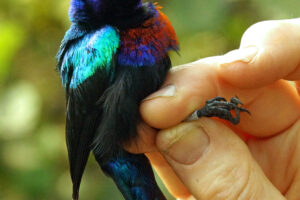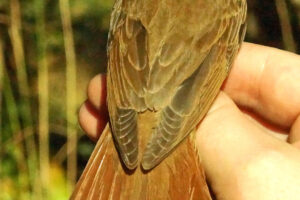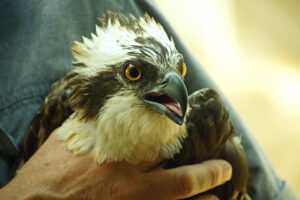I have just returned from two weeks in the West African Country of The Gambia where I stayed with 12 other volunteers from the UK; at the Kartong Bird Observatory. This was far removed from a normal birding holiday as we started every morning before 6:00, working on the ‘local’ birds until around noon. We then had lunch and generally were so tired (or just needed to hide from the 35C heat) that we rested until 16:30. We would then set out to survey and set mist nets at a new site and ring birds for an hour or two. Before it went dark, we would furl the nets up tight and secure everything so as to be able to return to this location again the following morning (we did not use nets at night for fear of catching the local bats which carry Rabies). The formal purpose of the observatory is ‘to study bird populations and migration (and other fauna and flora) using bird ringing and other appropriate techniques, making available the results to the Gambian Dept. of Parks and Wildlife Management and other interested parties; and provide public education and local training opportunities.’ Like all Bird Observatories advice and assistance is provided to visiting Bird Watchers and other Naturalists (and quite few people came to watch us working) but unusually the observatory always supports local development initiatives and good causes. This includes sponsoring a dental service which visits the local school and village and we were all asked to bring out new toothbrushes for the local community in our luggage.
As well as excess toothbrushes in our luggage and standard ringing equipment (like some new nets) we also had to persuade airport customs and security that taking 3 x 1kg lump hammers to the Gambia was legitimate baggage!
The fieldwork collects masses of data on the resident Afro-tropical birds to understand their basic biology, moult strategies, establish better criteria to determine their age, and improve identification. Year to year comparisons provides a better understanding of their survival and simple capture records confirm the presence and abundance of the species in this area of southern Gambia. We also see and ring many Western Palearctic species – these are ‘our’ birds that we see in the British Isles and other parts of Europe during our summer but migrate to Africa in the Autumn. Study of these birds tells us more about their survival and biological requirements. Kartong Bird Observatory is currently collaborating with several academic ornithologists from for example:
Cardiff University: Blood sampling for population analysis of the African Jacana.
University of Aveiro, Portugal & University of Iceland: Whimbrel migration.
RSPB & Lancaster University: Masses of migratory Common Sandpipers and migration.
Nottingham Trent University: Pollution detection in wading birds.
University of Cape Town & National Zoological Gardens of South Africa: Intra-African Migration
British Trust for Ornithology: Migration and ecology of the Common Nightingale.
When I have sorted out my many photographs, I hope to offer an interesting talk to the local Natural History groups and societies but for the present I have chosen just four birds to illustrate what we did in practical terms. We captured several Nightingales one of which was carrying a miniature back-pack under its feathers – this was a geo-logger which will enable the BTO to determine the details of its migration from southern England to the Gambia (see pict.).
We captured and ringed a number of Reed Warblers including one with a BTO ring (a Control) which we have already discovered was ringed at Marston Sewage Works in Lincolnshire on the 5th August 2019; having travelled 4,662 km’s. However, I was given a bag with a bird in it to ring which proved to be its larger relative – a Great Reed Warbler (see pict.). This is a species which provoke great excitement amongst birders a few years ago when one turned up at Gosforth Park Nature Reserve one summer.
Everyone was flabbergasted, one very hot day, when one of our local Gambian trainees started sprinting across one of the wetland ringing sites and we realised that there was something very large in one our mist nets. This turned out to be an adult Osprey – complete with rings showing it had been ringed in Scotland (near Kintyre on the west coast) in its nest in 2018. This type of capture had never happened before and while pondering the explanation, the next day, we captured another one in the same manner! I should have perhaps prefaced this section by saying that we were seeing several Ospreys fishing in the near-by sea every day and we can only conclude that the birds are coming a little inland to bathe and drink in fresh water, and sometimes they just don’t see the mist nets set for smaller passerines and waders. Wonders never ceased, as we captured a third Osprey on another day and this bird proved to be a very large female bird which required to be fitted with an extra-large ring!
Every day we captured a bird that all birders like to see; the relatively common Beautiful Sunbird but late in the expedition I had the pleasure of ringing its relative the Splendid Sunbird with its head and throat of glossy purple (see pict.) this was the only one for the whole trip.
At the end of the expedition we had captured and processed an incredible 2,983 bird records each representing valuable ornithological data. Two local Gambian trainees were to be recommended to the BTO for their C permits and all us Brits were exhausted but happy with what we had achieved.
If interested in ringing please get in touch. Phil Hanmer ‘A’ Ringer/Trainer; Natural History Society of Northumbria Ringing Group (Hancock Museum). E-mail: tytoalbas@btinternet.com


